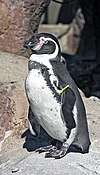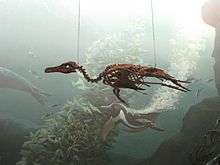Banded penguin
The banded penguins are penguins that belong to the genus Spheniscus. There are four living species of penguins known as banded penguins, and all have similar coloration. They are sometimes also known as "jack-ass penguins" due to their loud locator calls sounding similar to a donkey braying.[1] Common traits include a band of black that runs around their bodies bordering their black dorsal coloring, black beaks with a small vertical white band, distinct spots on their bellies, and a small patch of unfeathered or thinly feathered skin around their eyes and underdeveloped fluff sack that can be either white or pink. All members of this genus lay eggs and raise their young in nests situated in burrows or natural depressions in the earth.[2][3]
| Banded penguin | |
|---|---|
.jpg) | |
| Spheniscus demersus, the African penguin | |
| Scientific classification | |
| Kingdom: | Animalia |
| Phylum: | Chordata |
| Class: | Aves |
| Order: | Sphenisciformes |
| Family: | Spheniscidae |
| Genus: | Spheniscus Brisson 1760 |
| Type species | |
| Spheniscus demersus | |
| Species | |
Systematics
Banded penguins belong to the genus Spheniscus, which was introduced by the French zoologist Mathurin Jacques Brisson in 1760 with the African penguin (Spheniscus demersus) as the type species.[4][5] The genus name Spheniscus is derived from the Ancient Greek word σφήν (sphẽn) meaning "wedge" and is a reference to the animal's thin, wedge-shaped flippers.[6][7]
Species
Extant
The four extant species of banded penguins (Spheniscus) are:
| Image | Common name | Binomial name | Distribution |
|---|---|---|---|
| Magellanic penguin | Spheniscus magellanicus | Brazil, coastal Argentina, Chile and the Falkland Islands | |
 |
Humboldt penguin | Spheniscus humboldti | coastal Chile and Peru |
_-Isabela2.jpg) |
Galapagos penguin | Spheniscus mendiculus | Galápagos Islands. |
 |
African penguin, black-footed or jackass penguin | Spheniscus demersus | 24 islands and 3 mainland locations between Namibia and Algoa Bay, near Port Elizabeth, South Africa. |
Extinct

Several extinct species are known from fossils:
- Spheniscus anglicus (Late Miocene of Chile)
- Spheniscus chilensis (Late Miocene/Early Pliocene of Chile)
- Spheniscus megaramphus (Late Miocene/Early Pliocene of Peru and Chile)[8]
- Spheniscus muizoni (Middle/Late Miocene of Cerro La Bruja, Peru)[9]
- Spheniscus urbinai (Late Miocene/Early Pliocene of Peru and Chile)[8]
The former Spheniscus predemersus is now placed in a monotypic genus Inguza.
Range

Scientists believe that the genus Spheniscus originated in South America, even though the oldest fossils assigned to the taxon are from Antarctica. The oldest Spheniscus fossils are also the oldest penguin fossils from Antarctica.[10] African, Humboldt, and Magellanic penguins all live in temperate climates. The African penguin lives in South Africa, the Humboldt penguin lives in coastal Peru and Chile while the Magellanic penguin lives in coastal Chile, Argentina, and the Falkland Islands. Humboldt and Magellanic penguins are partially sympatric, since their ranges overlap in southern Chile.[11][12] The Galápagos penguin is endemic to the Galápagos Islands, making it the most northerly of all penguin species.[13]
Vocalizations
Banded penguins use vocalizations for localization, socialization and to allow recognition for conspecifics or mates.[14] Vocalizations in birds are produced by vibrations of the syrinx, located at the bottom of the trachea.[14][3] These penguins are sometimes referred to as "jack-ass" penguins, since their vocalizations tend to sound similar to a donkey braying.[1] Vocalizations in adult penguins can be classified into 4 distinct categories based on its acoustic properties and the behavioural context in which a vocalization is produced.[14] The 4 categories of vocalizations include contact calls, agonistic calls, ecstatic display songs or mutual display songs.[14]
Contact calls
Contact calls are vocalizations used primarily to maintain unity within a social group, to identify ones self and to maintain contact with a mate.[14] Vocal individuality has evolved in banded penguins due to their large social group sizes.[15] Contact calls are frequently used by banded penguins to form large flocks when foraging at sea.[14] It is easy to become separated while diving for food, therefore these penguins use contact calls to stay in contact with each other when they are out of sight.[14] A contact call can relay an excess of information about an individual penguin, including the penguins sex, age, social status within a group and emotional state.[16]
.jpg)
Agonistic calls
Agonistic calls are vocalizations used when a banded penguin is demonstrating agonistic behaviour, which is characterized by aggressive interactions or fighting.[3] Typically, banded penguins vocalize agonistic calls when defending a territory, such as their nest, against conspecifics.[14] For nesting penguin species, such as banded penguins, the mating pair and their offspring are the only individuals allowed on their nest.[17] Thus, any conspecific from the large colony that intrudes this territory will be a threat and an agonistic call will be produced.[17]
Display songs
There are two types of display songs vocalized by banded penguins; ecstatic display songs and mutual display songs.[14] Ecstatic display songs are the loudest and most complex vocalization performed by banded penguins.[3] They are composed of a sequence of distinct acoustic syllables that combine to form a complete phrase and are often displayed during their breeding season.[3] Despite the close relatedness of banded penguin species, the ecstatic display calls of African, Humboldt and Magellanic penguins are distinctly recognizable, even to human listeners.[14] Typically, females respond more strongly to ecstatic display calls from their mates than from other conspecifics.[3] Furthermore, there is evidence to suggest that ecstatic display songs may convey vocal individuality through the type of syllables the song produces.[3] This vocal individuality can convey information such as body size and weight, since heavier penguins typically emit longer and lower-pitched vocalizations.[15] Mutual display songs are similar to ecstatic display songs in that they are also complex sequences of acoustic syllables. However, mutual display songs are performed by mates at their nesting site.[3]
Source-filter theory
The source-filter theory is a framework used for studying the communication of mammalian animals through vocalizations.[3] According to this theory, acoustic calls are produced by a source and then must be filtered to remove certain frequencies or leave others unchanged, which produces vocal individuality.[3] In mammals, the source is the vibrations in the larynx and the filter is the super laryngeal vocal tract.[3] However, birds use a different source and filter to produce vocalizations. They use a structure called the syrinx as their source of vibrations and their trachea acts as the filter.[3] The source-filter theory has become increasingly popular to study birds, such as various species of banded penguins. This theory can be used to investigate how acoustic variation and individuality within a set of closely related species is attributed to distinct morphological differences in their vocal organs.[3] The equivalence of the source-filter theory in humans is the source-filter model of speech production.
References
- Favaro L; Ozella L; Pessani D (20 July 2014). "The Vocal Repertoire of the African Penguin (Spheniscus demersus): Structure and Function of Calls". PLoS ONE. 9 (7): e103460. doi:10.1371/journal.pone.0103460. PMC 4116197. PMID 25076136.
- Ellis, Richard (2004). No Turning Back: The Life and Death of Animal Species. New York: Harper Perennial. p. 69. ISBN 978-0-06-055804-8.
- Favaro, Livio; Gamba, Marco; Gili, Claudia; Pessani, Daniela (2017-02-15). "Acoustic correlates of body size and individual identity in banded penguins". PLoS ONE. 12 (2): e0170001. doi:10.1371/journal.pone.0170001. ISSN 1932-6203. PMC 5310857. PMID 28199318.
- Brisson, Mathurin Jacques (1760). Ornithologie, ou, Méthode contenant la division des oiseaux en ordres, sections, genres, especes & leurs variétés (in French and Latin). Volume 1. Paris: Jean-Baptiste Bauche. Vol. 1, p. 42, Vol. 6, p. 96.
- Mayr, Ernst; Cottrell, G. William, eds. (1979). Check-list of Birds of the World. Volume 1 (2nd ed.). Cambridge, Massachusetts: Museum of Comparative Zoology. p. 133.
- Jobling, James A. (2010). The Helm Dictionary of Scientific Bird Names. London: Christopher Helm Publishers. pp. 361. ISBN 978-1408125014.
- Liddell, Henry George; Scott, Robert (1940). "σφήν". A Greek–English Lexicon (Ninth ed.). Oxford: Clarendon Press.
- Stucchi, 2007, p.370
- Göhlich, 2007, p.287
- Jadwiszczak, Piotr; Krajewski, Krzysztof P.; Pushina, Zinaida; Tatur, Andrzej; Zieliński, Grzegorz (2013-06-01). "The first record of fossil penguins from East Antarctica". Antarctic Science. 25 (3): 397–408. doi:10.1017/S0954102012000909. ISSN 0954-1020.
- Hiriart-Bertrand, Luciano; Simeone, Alejandro; Reyes-Arriagada, Ronnie; Riquelme, Victoria; Pütz, Klemens; Lüthi, Benno (January 2010). "Description of a mixed-species colony of Humboldt (Spheniscus humboldti) and Magallanic Penguins (S. magellanicus) at Metalqui Island, Chiloé, southern Chile". Boletín Chileno de Ornitologia. 16 (1): 42–47.
- Pütz, Klemens; Raya Rey, Andrea; Hiriart-Bertrand, Luciano; Simeone, Alejandro; Reyes-Arriagada, Ronnie; Lüthi, Benno (July 2016). "Post-moult movements of sympatrically breeding Humboldt and Magellanic Penguins in south-central Chile". Global Ecology and Conservation. 7: 49–58. doi:10.1016/j.gecco.2016.05.001.
- Carlson, Annica Lila; Townsdin, Jens Steven (2012). "Galapagos Penguin (Spheniscus mendiculus)". Neotropical Birds. 1.0. doi:10.2173/nb.galpen1.01.
- Favaro, Livio; Gili, Claudia; Rugna, Cristiano Da; Gnone, Guido; Fissore, Chiara; Sanchez, Daniel; McElligott, Alan G.; Gamba, Marco; Pessani, Daniela (2016). "Vocal individuality and species divergence in the contact calls of banded penguins". Behavioural Processes. 128: 83–88. doi:10.1016/j.beproc.2016.04.010. PMID 27102762.
- Favaro, Livio; Gamba, Marco; Alfieri, Chiara; Pessani, Daniela; McElligott, Alan G. (2015-11-25). "Vocal individuality cues in the African penguin (Spheniscus demersus): a source-filter theory approach". Scientific Reports. 5 (1): 17255. doi:10.1038/srep17255. ISSN 2045-2322. PMC 4658557. PMID 26602001.
- Briefer, E.F., Te amanti, F., & McElligo, A.G. (2015). "Emotions in goats: mapping physiological, behavioural and vocal profiles" (PDF). Animal Behaviour. 99: 131–143. doi:10.1016/j.anbehav.2014.11.002.CS1 maint: multiple names: authors list (link)
- Jouventin, Pierre; Aubin, Thierry (2002). "Acoustic systems are adapted to breeding ecologies: individual recognition in nesting penguins". Animal Behaviour. 64 (5): 747–757. doi:10.1006/anbe.2002.4002.
Bibliography
- Göhlich, Ursula B. 2007. The oldest fossil record of the extant penguin genus Spheniscus — a new species from the Miocene of Peru. Acta Palaeontologica Polonica 52. 285–298. Accessed 2019-03-13.
- Stucchi, M. 2007. Los pingüinos de la Formación Pisco (Neógeno), Perú. 4th European Meeting on the Palaeontology and Stratigraphy of Latin America, Cuadernos del Museo Geominero 8. 367–373. Accessed 2019-03-13.